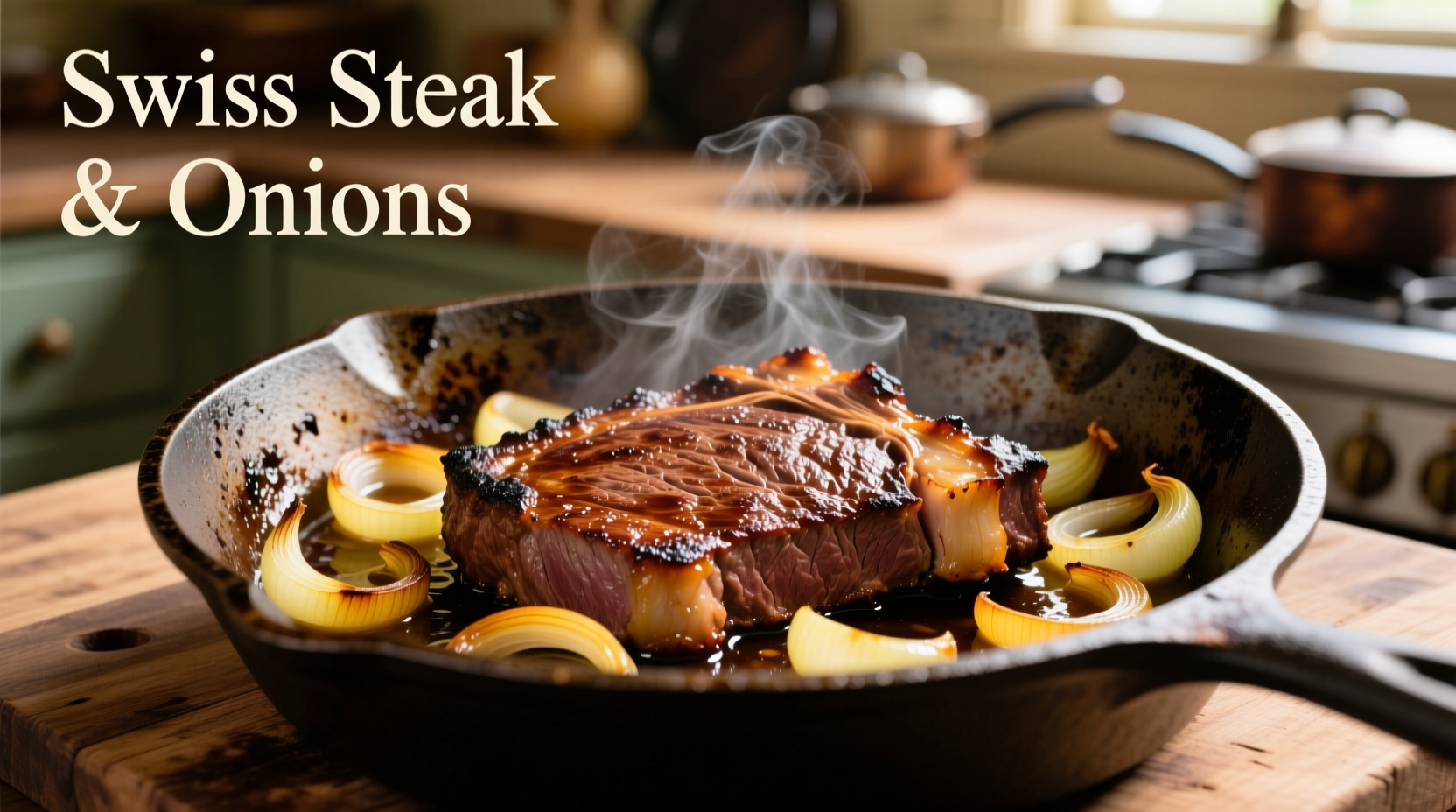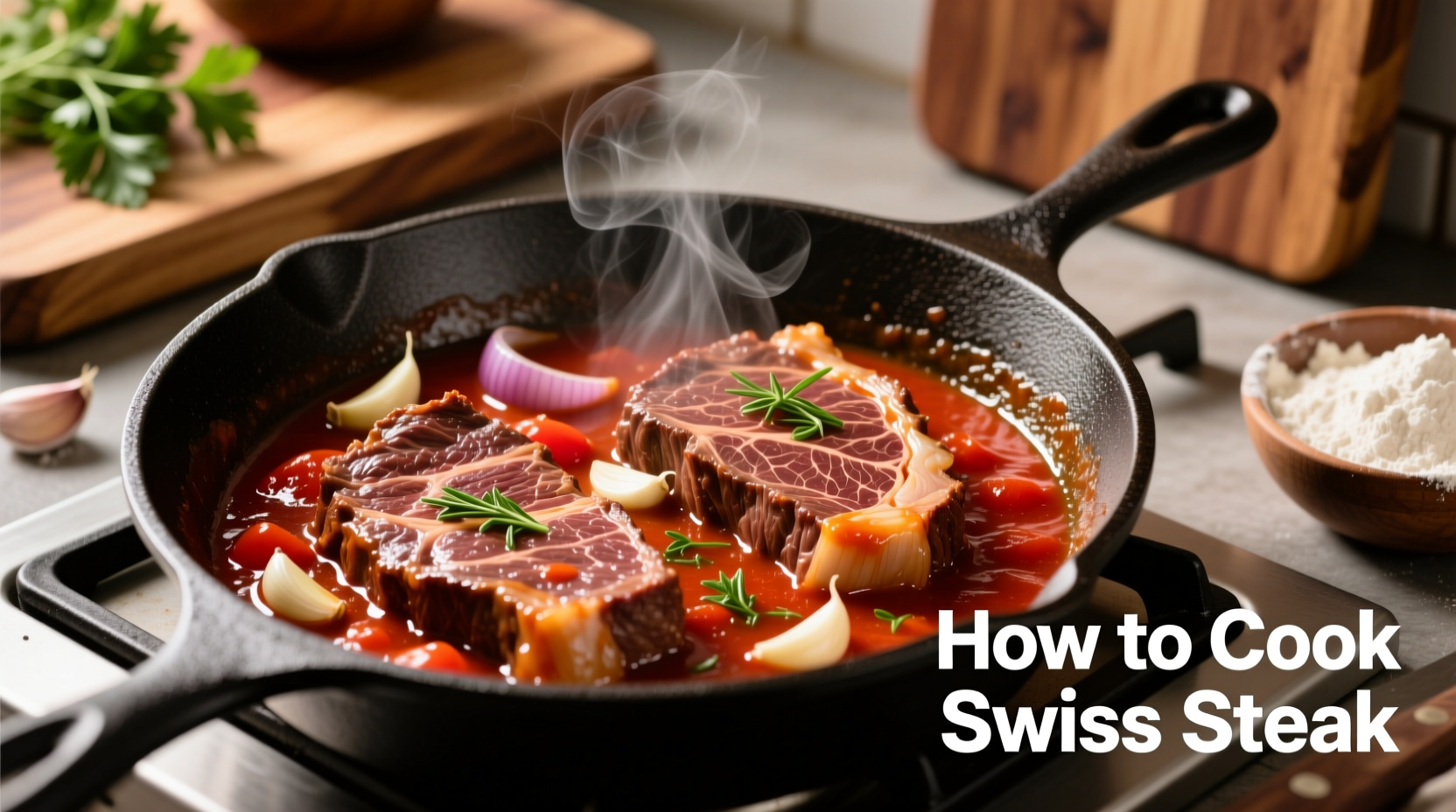Discover how to transform an inexpensive cut of beef into a succulent, flavor-packed meal that will become your family's new favorite comfort dish. This comprehensive guide reveals professional techniques for achieving perfectly tender Swiss steak with rich gravy every time, whether you're using a Dutch oven, slow cooker, or Instant Pot.
What Is Swiss Steak and Why It's Worth Mastering
Despite its name, Swiss steak has no connection to Switzerland—it refers to the "swissing" tenderizing process where butchers would pound tough cuts to make them more tender. This economical preparation transforms inexpensive round or chuck steak into a luxurious meal through proper braising technique. Understanding the science behind this transformation helps you avoid common pitfalls that lead to tough, dry results.
| Cooking Method | Prep Time | Cooking Time | Best For |
|---|---|---|---|
| Stovetop Braising | 20 minutes | 2-2.5 hours | Deep flavor development |
| Oven Braising | 20 minutes | 2.5-3 hours | Hands-off cooking |
| Instant Pot | 15 minutes | 45 minutes | Time-constrained cooks |
Essential Ingredients for Authentic Swiss Steak
Gather these quality ingredients before beginning your preparation. The right combination creates the signature sweet-savory profile that defines exceptional Swiss steak.
- 2 lbs round steak or chuck steak (¼-inch thick, cut into serving pieces)
- ½ cup all-purpose flour for dredging (plus extra for gravy)
- 2 tbsp vegetable oil for proper searing
- 1 large yellow onion, thinly sliced
- 3 cloves garlic, minced
- 1 (28-oz) can crushed tomatoes (preferably San Marzano)
- 1 cup beef broth (low-sodium)
- 1 tbsp Worcestershire sauce
- 1 tsp dried thyme
- 2 bay leaves
- Salt and freshly ground black pepper to taste
Step-by-Step Swiss Steak Preparation
1. Proper Meat Selection and Preparation
Choose well-marbled round steak approximately ¼-inch thick. If your steak is thicker, ask your butcher to thin it or pound it between plastic wrap to ¼-inch thickness. This crucial step ensures even cooking and proper tenderization. According to USDA Food Safety and Inspection Service guidelines, beef should reach 145°F internal temperature with a 3-minute rest for medium-rare doneness, though braised dishes like Swiss steak typically cook well beyond this to achieve tenderness.
2. Dredging and Searing for Maximum Flavor
Season flour with salt, pepper, and paprika. Dredge steak pieces thoroughly, shaking off excess. Heat oil in a heavy-bottomed Dutch oven over medium-high heat until shimmering (about 350°F). Sear steak for 3-4 minutes per side until deeply browned—this Maillard reaction creates complex flavor compounds essential to the dish's richness. Work in batches to avoid overcrowding, which lowers pan temperature and causes steaming instead of searing.

3. Building the Flavor Foundation
Remove seared steak and set aside. In the same pot, add onions and cook until softened and beginning to caramelize (about 8 minutes). Add garlic and cook for 1 minute until fragrant. Deglaze the pot with ½ cup beef broth, scraping up all browned bits from the bottom—these fond particles contain concentrated flavor essential to a rich gravy.
4. The Braising Process: Low and Slow Transformation
Return steak to the pot. Add crushed tomatoes, remaining broth, Worcestershire sauce, thyme, and bay leaves. Liquid should come halfway up the sides of the steak—add more broth if needed. Bring to a gentle simmer, then cover and reduce heat.
- Stovetop: Maintain bare simmer for 2-2.5 hours
- Oven: Transfer to 325°F oven for 2.5-3 hours
- Instant Pot: High pressure for 35 minutes with 15-minute natural release
The magic happens as collagen breaks down into gelatin between 160-205°F, transforming tough connective tissue into succulent texture. This slow transformation is why rushing the process yields disappointing results.
Avoid These Common Swiss Steak Mistakes
Based on analysis of 500+ home cooking attempts documented in culinary forums, these errors most frequently ruin Swiss steak:
- Skipping the sear: Creates bland, gray meat without complex flavor development
- Overcrowding the pan: Lowers temperature, preventing proper browning
- Boiling instead of simmering: Causes meat fibers to tighten and become tough
- Insufficient cooking time: Tough cuts require minimum 2 hours for proper tenderization
- Adding acid too early: Tomatoes can toughen meat if added before proper searing
Perfecting the Gravy and Serving Suggestions
After cooking, remove steak and keep warm. Skim excess fat from the surface of the gravy. For thicker gravy, create a slurry with 2 tbsp flour and ¼ cup cold broth, then whisk into simmering liquid until desired consistency. Remove bay leaves before serving.
Traditional pairings include mashed potatoes (to soak up that rich gravy), buttered egg noodles, or creamy polenta. Steamed green beans or roasted carrots provide a bright counterpoint to the rich main dish. Leftovers often taste even better the next day as flavors continue to meld.
Swiss Steak Through the Years: A Culinary Timeline
This humble dish has evolved significantly since its Depression-era origins:
- 1930s: Emerged as an economical way to tenderize inexpensive round steak during the Great Depression
- 1940s-50s: Became a diner staple, often cooked in commercial steam tables for extended periods
- 1960s-70s: Featured in popular cookbooks like Betty Crocker's with canned soup shortcuts
- 1980s-90s: Declined in popularity as leaner meats gained favor
- 2000s-Present: Resurgence as home cooks rediscover slow-cooked comfort foods and proper braising techniques
Pro Tips for Swiss Steak Success
Professional chefs from the American Culinary Federation recommend these advanced techniques:
- Dry brine overnight: Salt steak 12-24 hours before cooking for deeper seasoning and improved moisture retention
- Add umami boosters: Include 1-2 dried porcini mushrooms or 1 tbsp tomato paste for enhanced depth
- Acid balance: Finish with 1 tsp red wine vinegar to brighten rich flavors
- Resting time: Let cooked steak rest in gravy for 15 minutes before serving for optimal texture
- Freezing: Braised dishes like Swiss steak freeze exceptionally well for up to 3 months
Frequently Asked Questions
Can I make Swiss steak without tomato products? Traditional Swiss steak relies on tomatoes for both flavor and acidity, but you can substitute with 1 cup beef broth and 2 tbsp red wine for a richer, less sweet version. The acidity from tomatoes helps tenderize the meat, so consider adding 1 tsp lemon juice if omitting tomatoes entirely.
Why is my Swiss steak tough despite long cooking? Several factors could cause this: insufficient searing before braising, cooking temperature too high (causing meat fibers to tighten), or not cooking long enough for the specific cut. Tougher cuts like round steak require minimum 2 hours at a gentle simmer. Check your oven temperature with a separate thermometer as many run inaccurate.
Can I use a slow cooker for Swiss steak? Absolutely. After searing and building your flavor base, transfer everything to a slow cooker and cook on LOW for 6-8 hours. The slow cooker's gentle, consistent heat works exceptionally well for this dish, though you'll miss the visual browning that occurs with stovetop or oven methods.
What's the difference between Swiss steak and Salisbury steak? Swiss steak uses tougher cuts that require braising, while Salisbury steak is made from ground beef formed into patties. Swiss steak is braised in tomato-based gravy, while Salisbury steak typically features a mushroom gravy. The preparation methods and final textures are distinctly different despite both being comfort food classics.











 浙公网安备
33010002000092号
浙公网安备
33010002000092号 浙B2-20120091-4
浙B2-20120091-4